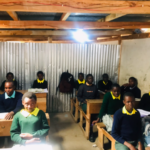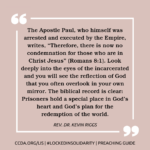As we head into the summer months, the familiar question, “Are we there yet?” will be a frequent refrain. This question will be repeatedly asked on car trips with family, heading to camp with students and by anyone with a long, unfamiliar road ahead of them.
Doing justice in our communities can often feel a lot like an unfamiliar road trip riddled with potholes, detours, missed milestones and overheated engines. We can find ourselves stranded on the side of the road, wanting to give up and begging an answer to the question, “Are we there yet?” Or more realistically, “Will we ever be there? How much farther?”
Years ago, at one of my first CCDA conferences, I heard a speaker share the analogy of “going upstream” to get at the core of helping hurting people. As practitioners on the front lines, we knew firsthand how it felt to daily pull the proverbial bodies out of the river over and over again. We knew there was a problem, and we knew that in addition to that good life-saving work, we, at some point, would also need to use some energy to head upstream to see who was throwing those we loved in.
That analogy provided a great picture, allowing me to reflect on my personal experiences in seeking the welfare of my community in Denver. I wanted to do what was good and required by the Lord (Micah 6:8). Loving mercy––while really hard––was a reaction to the present, pressing problems in the immediate moment. Taking time to look to a proactive, justice response would require a bit more “doing” and walking upstream. We needed to figure out who or what was throwing our neighbors into the river.
Whether it is supporting single moms, helping those leaving prison find jobs, tutoring youth, driving vans to camp, or making food in church basements, our association is replete with practitioners who live the balance of loving mercy and doing justice every day, meeting felt needs and supporting individuals and communities with opportunities to reflect the flourishing communities God intended for His kingdom here on earth. But, as we do justice, how far upstream are we supposed to go?
This question, which I have asked myself for years, is why I began working in faith-rooted organizing and public policy advocacy, to speak into the systemic injustices that keep people and communities in a broken place. As I walked up that river, I realized that the wrongs that needed righting were a lot bigger than I had originally thought, the journey a bit more unfamiliar than I had anticipated.
Living in an immigrant community, I have witnessed firsthand the struggles that many immigrant families face. As a former teacher in at-risk, immigrant schools, I knew that parents were desperate to ensure that their kids had educational opportunities that would enable them to go far in life. Unfortunately, the school systems in my community didn’t afford enough of what they needed. At one point, every school in my neighborhood was failing, with no middle school option because ours had closed due to poor test grades. Our local school system was not able to do enough on its own.
Thankfully we have some really great community development ministries in my neighborhood to help students with their academic challenges and some really great local churches who are eagerly partnering with our local schools to make sure kids don’t fall through the cracks.
Local church communities like mine are sharing the good news of Jesus and discipling students. They are hosting back-to-school supply parties and supporting student academic efforts—not just with free crayons and backpacks, but with one-on-one tutoring.
This is all vital, upstream, justice and mercy work—but does it go far enough upstream to ensure that these kids are successful? Does it do enough to ensure that these students finish high school, head off to college and become educated, integrated Americans? What about legal status issues, fair wages, access to resources for higher education, the effects of incarceration on families, or racial profiling? How do we respond to these systemic issues, when no matter how hard those in our community work, they keep hitting the all-too-familiar ceiling of the cycles of brokenness and poverty?
CCDA has a long-standing commitment to justice work that includes confronting systems that keep people and often whole sections of our communities in broken places. We know that these injustices cannot be ignored. Even though the walk upstream is longer than we had anticipated, harder than we had trained for and filled with a sense of urgency that can at times make us frantic, we will not stop short of the goal: to see God’s justice here are on earth as it is in heaven.
In the coming months, we will be launching our advocacy and biblical justice web presence. We believe that our stories are too important not to share, our experiences and perspectives too valuable to leave out of the justice conversation. We want to bring what we have learned to a shared space to better inspire, train and connect us all in our individual and collective confrontations of injustice.
Long trips are inevitable; weary travelers are nothing new. But, our hope is that we will at least share this journey together more effectively so that when one of us asks, “Are we there yet?” we have someone––or a whole lot of someones––to say, “Not yet, baby, we are still walking farther upstream, together.”





